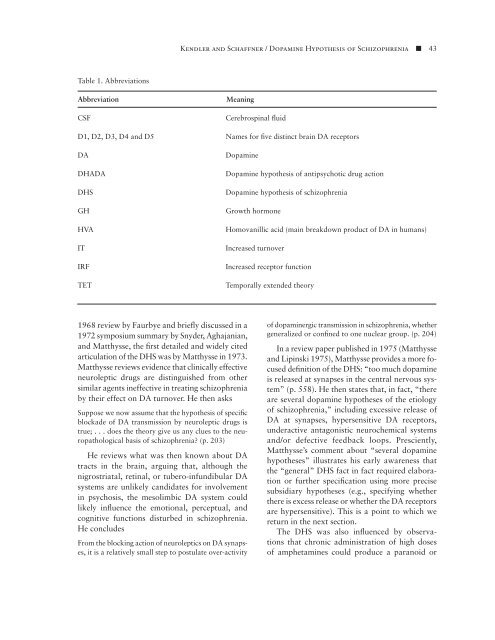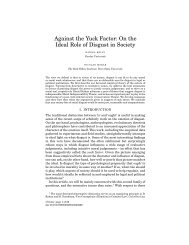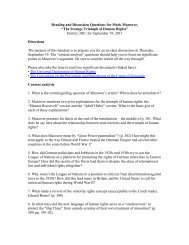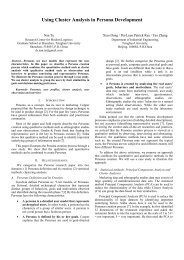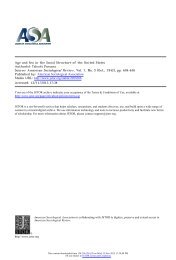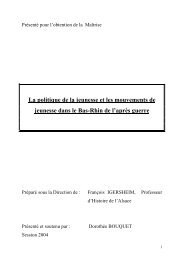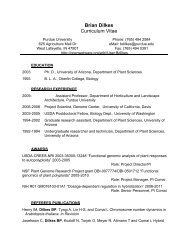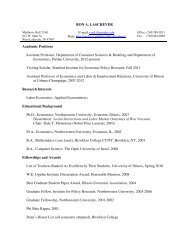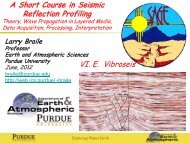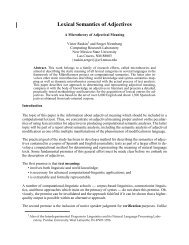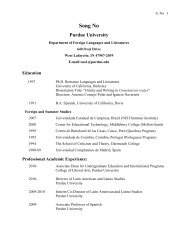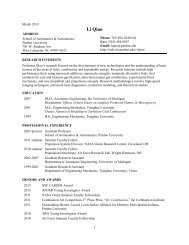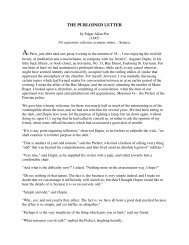The Dopamine Hypothesis of Schizophrenia: An Historical and ...
The Dopamine Hypothesis of Schizophrenia: An Historical and ...
The Dopamine Hypothesis of Schizophrenia: An Historical and ...
Create successful ePaper yourself
Turn your PDF publications into a flip-book with our unique Google optimized e-Paper software.
Kendler <strong>and</strong> Schaffner / <strong>Dopamine</strong> <strong>Hypothesis</strong> <strong>of</strong> <strong>Schizophrenia</strong> ■ 43<br />
Table 1. Abbreviations<br />
Abbreviation<br />
CSF<br />
Meaning<br />
Cerebrospinal fluid<br />
D1, D2, D3, D4 <strong>and</strong> D5 Names for five distinct brain DA receptors<br />
DA<br />
DHADA<br />
DHS<br />
GH<br />
HVA<br />
IT<br />
IRF<br />
TET<br />
<strong>Dopamine</strong><br />
<strong>Dopamine</strong> hypothesis <strong>of</strong> antipsychotic drug action<br />
<strong>Dopamine</strong> hypothesis <strong>of</strong> schizophrenia<br />
Growth hormone<br />
Homovanillic acid (main breakdown product <strong>of</strong> DA in humans)<br />
Increased turnover<br />
Increased receptor function<br />
Temporally extended theory<br />
1968 review by Faurbye <strong>and</strong> briefly discussed in a<br />
1972 symposium summary by Snyder, Aghajanian,<br />
<strong>and</strong> Matthysse, the first detailed <strong>and</strong> widely cited<br />
articulation <strong>of</strong> the DHS was by Matthysse in 1973.<br />
Matthysse reviews evidence that clinically effective<br />
neuroleptic drugs are distinguished from other<br />
similar agents ineffective in treating schizophrenia<br />
by their effect on DA turnover. He then asks<br />
Suppose we now assume that the hypothesis <strong>of</strong> specific<br />
blockade <strong>of</strong> DA transmission by neuroleptic drugs is<br />
true; . . . does the theory give us any clues to the neuropathological<br />
basis <strong>of</strong> schizophrenia? (p. 203)<br />
He reviews what was then known about DA<br />
tracts in the brain, arguing that, although the<br />
nigrostriatal, retinal, or tubero-infundibular DA<br />
systems are unlikely c<strong>and</strong>idates for involvement<br />
in psychosis, the mesolimbic DA system could<br />
likely influence the emotional, perceptual, <strong>and</strong><br />
cognitive functions disturbed in schizophrenia.<br />
He concludes<br />
From the blocking action <strong>of</strong> neuroleptics on DA synapses,<br />
it is a relatively small step to postulate over-activity<br />
<strong>of</strong> dopaminergic transmission in schizophrenia, whether<br />
generalized or confined to one nuclear group. (p. 204)<br />
In a review paper published in 1975 (Matthysse<br />
<strong>and</strong> Lipinski 1975), Matthysse provides a more focused<br />
definition <strong>of</strong> the DHS: “too much dopamine<br />
is released at synapses in the central nervous system”<br />
(p. 558). He then states that, in fact, “there<br />
are several dopamine hypotheses <strong>of</strong> the etiology<br />
<strong>of</strong> schizophrenia,” including excessive release <strong>of</strong><br />
DA at synapses, hypersensitive DA receptors,<br />
underactive antagonistic neurochemical systems<br />
<strong>and</strong>/or defective feedback loops. Presciently,<br />
Matthysse’s comment about “several dopamine<br />
hypotheses” illustrates his early awareness that<br />
the “general” DHS fact in fact required elaboration<br />
or further specification using more precise<br />
subsidiary hypotheses (e.g., specifying whether<br />
there is excess release or whether the DA receptors<br />
are hypersensitive). This is a point to which we<br />
return in the next section.<br />
<strong>The</strong> DHS was also influenced by observations<br />
that chronic administration <strong>of</strong> high doses<br />
<strong>of</strong> amphetamines could produce a paranoid or


